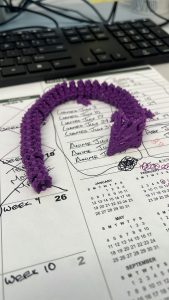When I worked in teen services, the ‘higher-ups’ spent a lot of time talking about providing spaces for teens to learn and explore without the pressures of receiving a grade or meeting particular expectations. I think all of that sounds amazing, and I do still feel that’s a great overarching mission for teen services. But I also tried to put that ideal into practice for two and a half years, and that proved to be very, very difficult. I think “Embracing Messy Learning” by Joshua Block captures why it’s so difficult to get teens to go along with the learning exploration we’re trying to get them to do: having a lot of choice can feel very messy and uncomfortable.
I think especially post-pandemic, teens have very little tolerance for doing something ‘difficult.’ And in a lot of cases, what we’re presenting them with is kind of overwhelming–not only are you dealing with a new technology or skill, you’re also expected to come up with what you want to do, which is daunting in itself. So then, you give them a bit of structure–you don’t have to decide what to screenprint, I’ll provide you some options. Instead of a video project about whatever you want, I’ll tell you to interview your friends. And then you run into the other issue with teens, which is that, generally speaking, they don’t like the ideas that adults come up with. They want to do their own thing. And then, unfortunately, you’re back at square one, with teens avoiding learning because of the messiness of new schools and open-ended projects.
A solution that Block offers for this is strategic modeling, which can look a few different ways. The strategic modeling I think is most relevant to the problem I’m describing is providing sample projects and projects created by other teens. I don’t think it’s effective, though, to build a program around something like zine-making and just kick it off with a few example zines. I think if we want teens to engage in a particular type of project, we need to have those projects out and accessible for them to explore independently of programming. I think an effective example we have of this is our 3D printers, which we’re told to keep visible and running in the teen areas as much as possible. Seeing the machine work generates a lot of interest, and that interest can then be leveraged into a 3D printing program. By seeing a project, the teens come to the technology organically. I think providing more ‘models’ like this could really help encourage learning within the teen library space.

A 3D printed dragon, which gets teens interested in 3D printing.
References
Block, J. (2014, January 7). Embracing Messy Learning. Edutopia. https://www.edutopia.org/blog/embracing-messy-learning-joshua-block
Block, J. (2013, October 28). Strategic Modeling: Balancing Structure with Choice. Edutopia. https://www.edutopia.org/blog/strategic-modeling-balancing-structure-choice-joshua-block